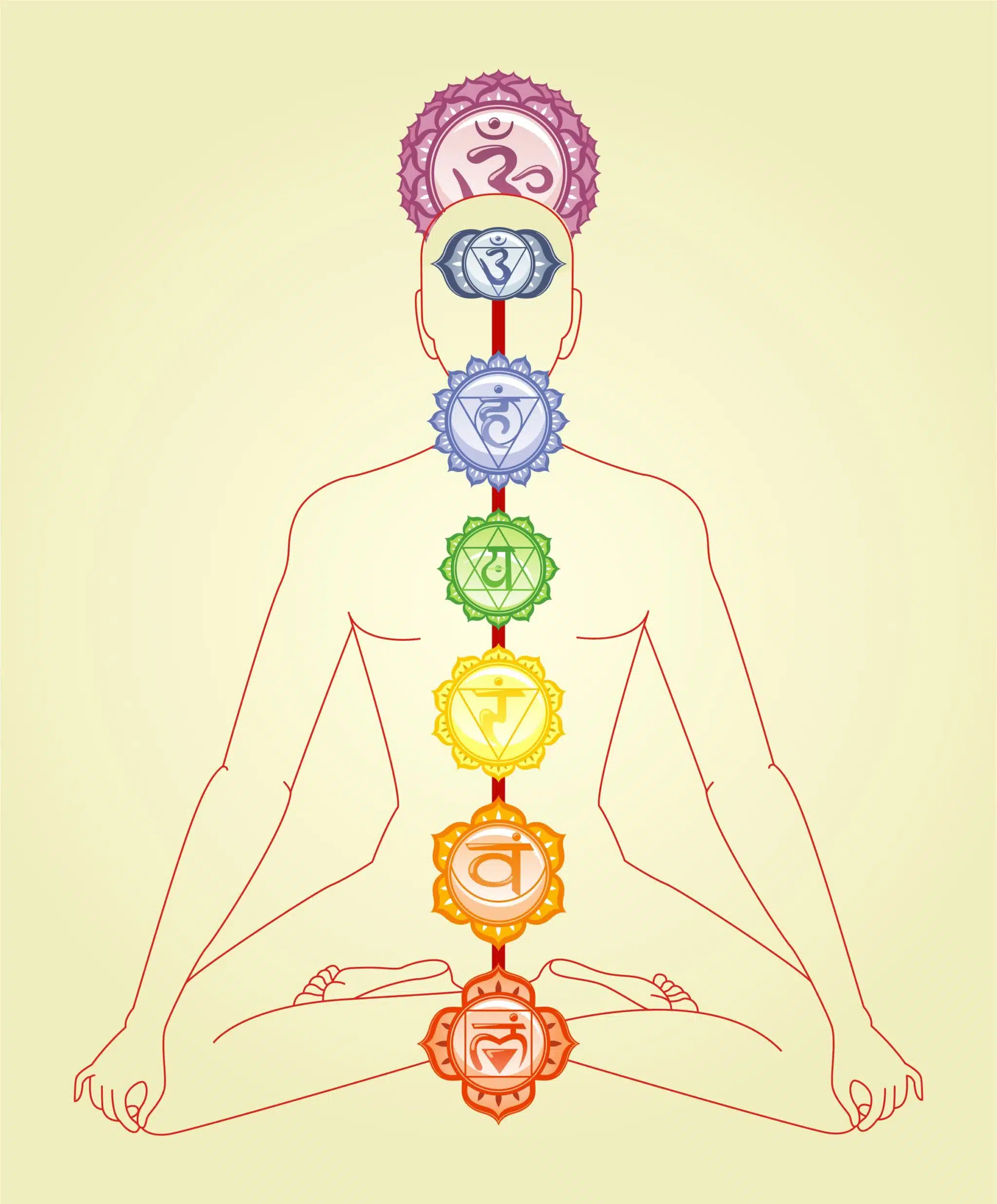By Em Motsick, CCH
The 3 Bodies
We all recognize that we have a physical body, but did you know that we also have an emotional and a spiritual body? We get movement in, try our best to eat well, and get adequate rest; all to nourish our physical body. A lot of times, our emotional needs get swept under the rug to make space for our hectic life, but what happens to them if they’re never revisited?
Emotions = Energy in Motion
When we hold emotions inside of us, or leave no space for their expression, they get stuck. I like to think of the emotional body as the bridge between our physical and spiritual bodies. Each unique emotion has a designated space in our body, within the 7-chakra system, which makes up part of our spiritual body. In this article, we will focus on the 7-chakra system, but know that we have anywhere from hundreds to thousands that reside in our body.
7-Chakra System
The word chakra comes from the Sanskrit word cakra, meaning “wheel” or “circle”. Chakras are often described as wheels of light, rotating and mediating the flow of energy between the body, mind, and spirit. Each one is unique, relating to an element, psychological health, world philosophies, and so much more. Each chakra holds an incredible amount of information and speaks directly to the interconnectedness of nature. Although not physical, they are thought to reside along the spine, starting from the base extending to the top of our head. I will use the terms higher and lower chakras, but know that these are not hierarchical descriptors. Let’s get to know each of the 7 chakras, starting from the lowest to highest.
Muladhara [Root] Chakra
Located at the base of the spine, the Root Chakra ensures our survival. It teaches us the element of earth, so we can reach stability, grounding, physical health, and prosperity. To connect with our root chakra, we must find stillness, security, and safety. One who has experienced a trauma where their safety was threatened or unfulfilled may experience root chakra imbalances. Physically this could look like eating disorders, financial difficulty, addiction, or material obsession. Emotionally, this could look like fear, stubbornness, or anxiety.
Svadhisthana [Sacral] Chakra
Governing our abdomen, genitals, low back, and hips, the Sacral Chakra teaches us femininity and the element of water so we can feel, move, desire, and tend. Connecting to the sacral chakra looks like soft movement, taking a sacred bath, honouring our body’s natural call for rest, and greeting emotions with softness. One who has experienced alcoholic families, repression of sexual identity or prolonged toxic masculinity may notice sacral imbalances. Some examples of physical imbalances of this chakra include reproductive disorders, frequent UTIs, and knee trouble. Emotionally, we would experience imbalance as perfectionism in creative expressions, numbness, and fear of change.
Manipura [Solar Plexus] Chakra
The Solar Plexus Chakra resides in our upper abdomen, deeply intertwined with our stomach, ego, and will. It teaches us the strength of fire and masculinity, creating self-definition. Through sunlight exposure, taking action, and feeling motivation or inspiration, we connect with this chakra. Enduring experiences of humiliation, narcissistic connections, and repeated failure can lead to solar plexus imbalances. We can often see this physically as digestive disorders, poor appetite, liver inflammation, and chronic fatigue. Signs of imbalance, emotionally, can include low self esteem, victim mentality, obsessive thinking, and micromanaging others.
Anahata [Heart] Chakra
Just as the name suggests, the Heart Chakra is the holder of our heart space. It is the element of air, breath, and life force, teaching us compassion, empathy, and acceptance of self and others. We can use breathwork, gratitude journaling, massaging our chest, and writing a letter of forgiveness as tools to connect to the Heart Chakra. Experiencing discrimination, emotional neglect, conditional love and betrayal are examples of traumas that could lead to imbalances. Physically, this can show up as asthma, heart disorders, and circulation issues. Emotionally, we may experience imbalances as fear of intimacy, narcissism, codependency, or being overly sacrificing.
Vishuddha [Throat] Chakra
The Throat Chakra resides in the throat and teaches us the element of sound. Through the vibration of sound, we find our voice, truth, and self-expression. Connecting with the Throat Chakra looks like singing, chanting, speaking our truth, and listening to strangers. Those who have experienced chronic invalidation, authoritarian parents, or being bullied for authentic expression can experience imbalances here. Physically, this can manifest as thyroid issues, jaw tension, and hearing problems. Emotionally, imbalances may appear as fear of speaking up, over-criticism, dishonesty, or inability to listen.
Anja [Third Eye] Chakra
Located between the eyebrows, the Third Eye Chakra governs intuition, insight, and perception. It teaches us the element of light, allowing us to see beyond the physical and into deeper truths. We can connect with the Third Eye Chakra through meditation, visualization, dreamwork, and trusting our inner knowing/intuition. Imbalances may stem from chronic gaslighting, psychological abuse, or an upbringing that discouraged free-thinking and curiosity. Physically, this can appear as headaches, vision problems, and hormonal imbalance. Emotionally, imbalance may manifest as paranoia, relying on logic only, excessive daydreaming, or nightmares.
Sahasrara [Crown] Chakra
Sitting at the crown of the head, the Crown Chakra is the gateway to divine connection, consciousness, and enlightenment. It is the element of thought, dissolving individuality and teaching unity between all life. Practices like meditation, studying, stargazing, and surrender help us attune to the teachings of the Crown Chakra. Imbalances may arise from forced religion, near-death experiences, or suppressing spiritual gifts. Physically, this can show up as migraines, neurological disorders, and overstimulation. Emotionally, we may experience dissociation from reality, over-intellectualizing, closed-mindedness, or spiritual addiction.
The teachings of the chakras are vast and complex. Black-and-white thinking can not be applied to the chakra system, as it requires thinking in the grey. These are mere explanations intended to spark a new way of perceiving your body, while understanding how trauma has played a role in your physical expressions. Take this as an opportunity to grow a deeper connection with yourself! There is so much more to uncover with this complex interconnection.
Sources
Eastern Body Western Mind by Anodea Judith

